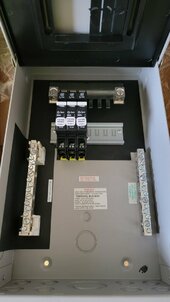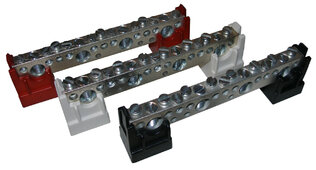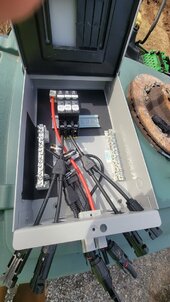I am concerned the breakers state in the specs, max volts dc 125V and the sticker on the breaker says 150V...Some midnite circuit breaker porn while we wait for release.
View attachment 197056View attachment 197057View attachment 197058
You are using an out of date browser. It may not display this or other websites correctly.
You should upgrade or use an alternative browser.
You should upgrade or use an alternative browser.
Midnite Solar Announced their new 10kw AIO at Intersolar Today
- Thread starter HighTechLab
- Start date
Brucey
Solar Wizard
Yeah not sure what's going on there but it's apparently good to go for the full 150V when used in a midnite enclosure.I am concerned the breakers state in the specs, max volts dc 125V and the sticker on the breaker says 150V...
"Description
MidNite’s breakers are rated to break the full rated load at the rated voltage repeatedly, with NO DAMAGE. Always use a properly sized breaker for disconnecting. MNEPV breakers are the same as CBI QY breakers except the standard used is inadequate for the solar industry. MidNite breakers have been evaluated by ETL to 150VDC and are listed for US and Canada. All of the NRTL listings still apply. Breakers ordered under the CBI part numbering system will not be listed for 150VDC and in many cases are not suitable for the solar industry. All MidNite circuit breakers can be used at 100% rated current when mounted in a MidNite enclosure."
I was nervous about a random China breaker failing or catching on fire, dozens of super cheap plastic combiner boxes with circuit breakers, surge and diodes available online but none of it seems code compliant.
littleharbor2
Solar Addict
I'm not sure I'd give that even an R Rating.Some midnite circuit breaker porn while we wait for release.
View attachment 197056View attachment 197057View attachment 197058
Hedges
I See Electromagnetic Fields!
- Joined
- Mar 28, 2020
- Messages
- 20,689
This one might have been X, if they'd had the foresight to video it:
Instead, as prose like "Lady Chatterly's Lover", it is pretty tame by modern standards.
Instead, as prose like "Lady Chatterly's Lover", it is pretty tame by modern standards.
Brucey
Solar Wizard
One of the reasons I went with midnite breakers. They will work if and when needed.This one might have been X, if they'd had the foresight to video it:
Instead, as prose like "Lady Chatterly's Lover", it is pretty tame by modern standards.
Brucey
Solar Wizard
Yes manufactured by Carling.Are those Carling Tech breakers?
I'm mistaken per Hedges post below.
Last edited:
Hedges
I See Electromagnetic Fields!
- Joined
- Mar 28, 2020
- Messages
- 20,689
I think CBI Electric and Carling Technologies are two different companies.
I've tested some breakers of each.

 diysolarforum.com
diysolarforum.com
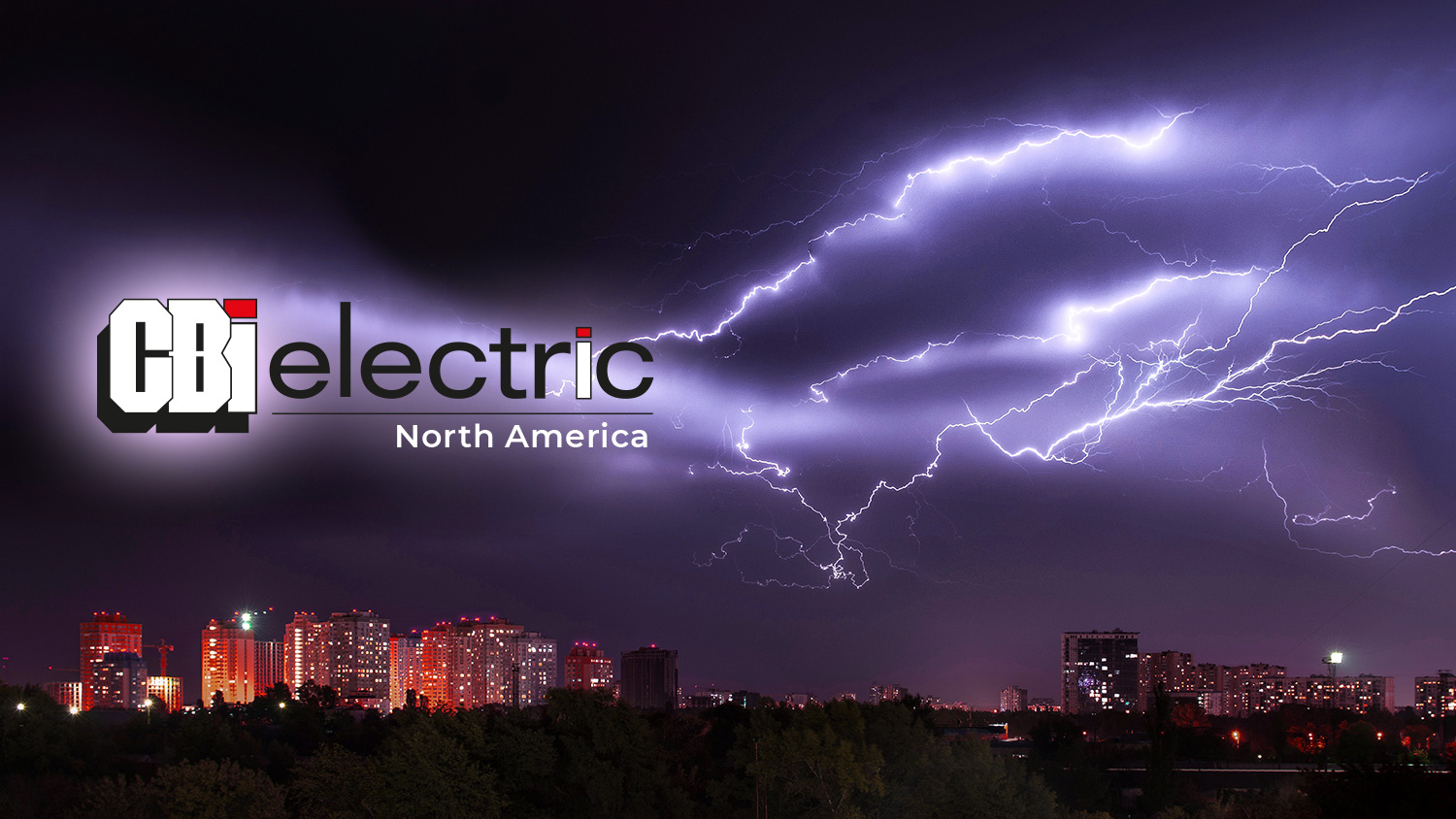
 cbibreakers.com
cbibreakers.com
I've tested some breakers of each.

Testing Magnetic-Hydraulic circuit breakers
I've built myself a circuit breaker tester. I assembled three transformers into a 3-phase wye auto-transformer, and by means of a breaker and cord/plug it can be repurposed into a current multiplier. A breaker connects X1 to H2 and H3, providing 4.7x current boost on X2 paralleled with X3...

CBi Inc Product Catalog
Rely on CBi to protect critical equipment from failure and damage caused by electrical overcurrent, overload or short circuit spikes and lags. Distributors across North America.
DIYrich
Solar Wizard
Connecticut has Energy Storage Solutions subsidy for batteries (virtual power plant). You might want to put on your list getting your equipment qualified (DERMS).
 energystoragect.com
energystoragect.com
Eligible Equipment List – Energy Storage Solutions
 energystoragect.com
energystoragect.com
Brucey
Solar Wizard
Mahendra Gomanie
Solar Enthusiast
Well it could if both are on common negative but this would be risky and unsafe and not code compliant.Not
To mention voiding warranty.
To mention voiding warranty.
ksmithaz1
Solar / EV Junkie
Sounds like a Darwin award is in your future.Mnpv6 arrived.
Anyone know if I can cut the bus bar in half and run three breakers to two Victron SCCs (150/35)? Basically can the Victrons handle a common negative bus when running in parallel? I've seen where the Midnite classics can but nothing on the Victrons. Thanks.
Brucey
Solar Wizard
If it's an issue I guess I can always combine the negatives of the second array separately from the first array.Well it could if both are on common negative but this would be risky and unsafe and not code compliant.Not
To mention voiding warranty.
ksmithaz1
Solar / EV Junkie
Look, not to put too fine a point on it. You seemed to be worried about "Cheap Chinese breakers", then proceed to suggest getting creative by modifying a combiner box, and wiring things in a non-standard way. I think you'd have been better off with a couple of home-made DIN rail combiner boxes with "Cheap Chinese breakers" one for each string feeding the MPPT's. As long as your the only one who will ever mess with it, and 5 years from now when some esoteric problem comes up and you remember what you did it shouldn't be a problem sharing the negative, and cutting bus bars in a cabinet. I just can't imagine why you would want to even consider it after worrying about buying a premium branded circuit breaker.
Brucey
Solar Wizard
Because my non standard way is specifically shown as a valid configuration by midnite when using their classic controllers? And they show where to cut the bus bar in the manual? So really the only question is if the Victron SCCs behave the same way as the Midnite classics.Look, not to put too fine a point on it. You seemed to be worried about "Cheap Chinese breakers", then proceed to suggest getting creative by modifying a combiner box, and wiring things in a non-standard way. I think you'd have been better off with a couple of home-made DIN rail combiner boxes with "Cheap Chinese breakers" one for each string feeding the MPPT's. As long as your the only one who will ever mess with it, and 5 years from now when some esoteric problem comes up and you remember what you did it shouldn't be a problem sharing the negative, and cutting bus bars in a cabinet. I just can't imagine why you would want to even consider it after worrying about buying a premium branded circuit breaker.
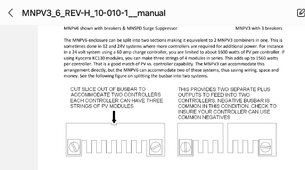
ksmithaz1
Solar / EV Junkie
Well then. . . If it's supported by the manufacturer of the combiner panel in their documentation, then your covered on the warranty side. As far as sharing the negative bus that should not really be an issue, but it should still be isolated from ground. I wouldn't do that, but the SCC's shouldn't care no matter the brand, as you shouldn't have a complete circuit to the other feed there should be no path.Because my non standard way is specifically shown as a valid configuration by midnite when using their classic controllers? And they show where to cut the bus bar in the manual? So really the only question is if the Victron SCCs behave the same way as the Midnite classics.
Because my non standard way is specifically shown as a valid configuration by midnite when using their classic controllers? And they show where to cut the bus bar in the manual? So really the only question is if the Victron SCCs behave the same way as the Midnite classics.
We usually just use a wire nut or a multitap connector when we have more than one set of PV wires in a Midnite MNPV3 or MNPV6.
I'm not 100% sure on the Victron SCCs, they may or may not work fine if the PV negatives were run together. I do know that Schneider MPPT60 SCCs can NOT have PV negative parallel between multiple units, and that is because they actually shunt the negative charge current inside of the SCC in order to track PV amps and it screws up their MPPT tracking when there is a parallel connection in the PV negative between 2 units! Been there, done that! We had swapped out from Midnite Classics, (I would pick Classics over SCH mppt60s any day!) because someone installed Classics with an XW and tried to sell in that setup and the Schneider "advanced sell" option actually works pretty good. Long story, ask me how "advanced sell" works if you want more details. Anyway, the Classics had PV negatives in parallel, we didn't give it any thought. It made issues with the Schneiders.....
The moral of the story is, it may or may not work with Victron, depending on whether or not they shunt negative current internally..... Obviously the Classics are watching current on the Positive, because the Negatives (PV and Batt) are common to each other.
Well then. . . If it's supported by the manufacturer of the combiner panel in their documentation, then your covered on the warranty side. As far as sharing the negative bus that should not really be an issue, but it should still be isolated from ground. I wouldn't do that, but the SCC's shouldn't care no matter the brand, as you shouldn't have a complete circuit to the other feed there should be no path.
As I mentioned above, apparently with some SCCs it doesn't work. Makes sense when you think of it the way SCH tech support explained to me that they shunt the Negative current.
littleharbor2
Solar Addict
MrM1
I'm Here, But I'm Not All There
Is this what we do when we get bored of waiting on info of a new release?
Brucey
Solar Wizard
Similar threads
- Replies
- 268
- Views
- 11K
- Replies
- 3
- Views
- 268
- Replies
- 5
- Views
- 633
- Replies
- 4
- Views
- 524



